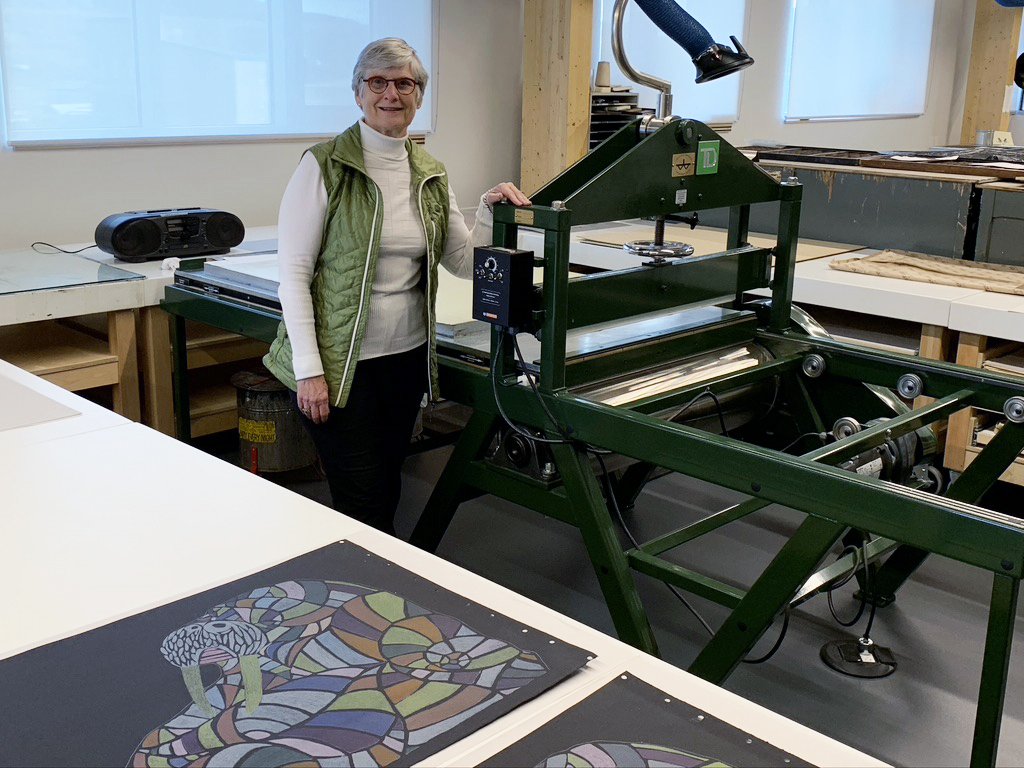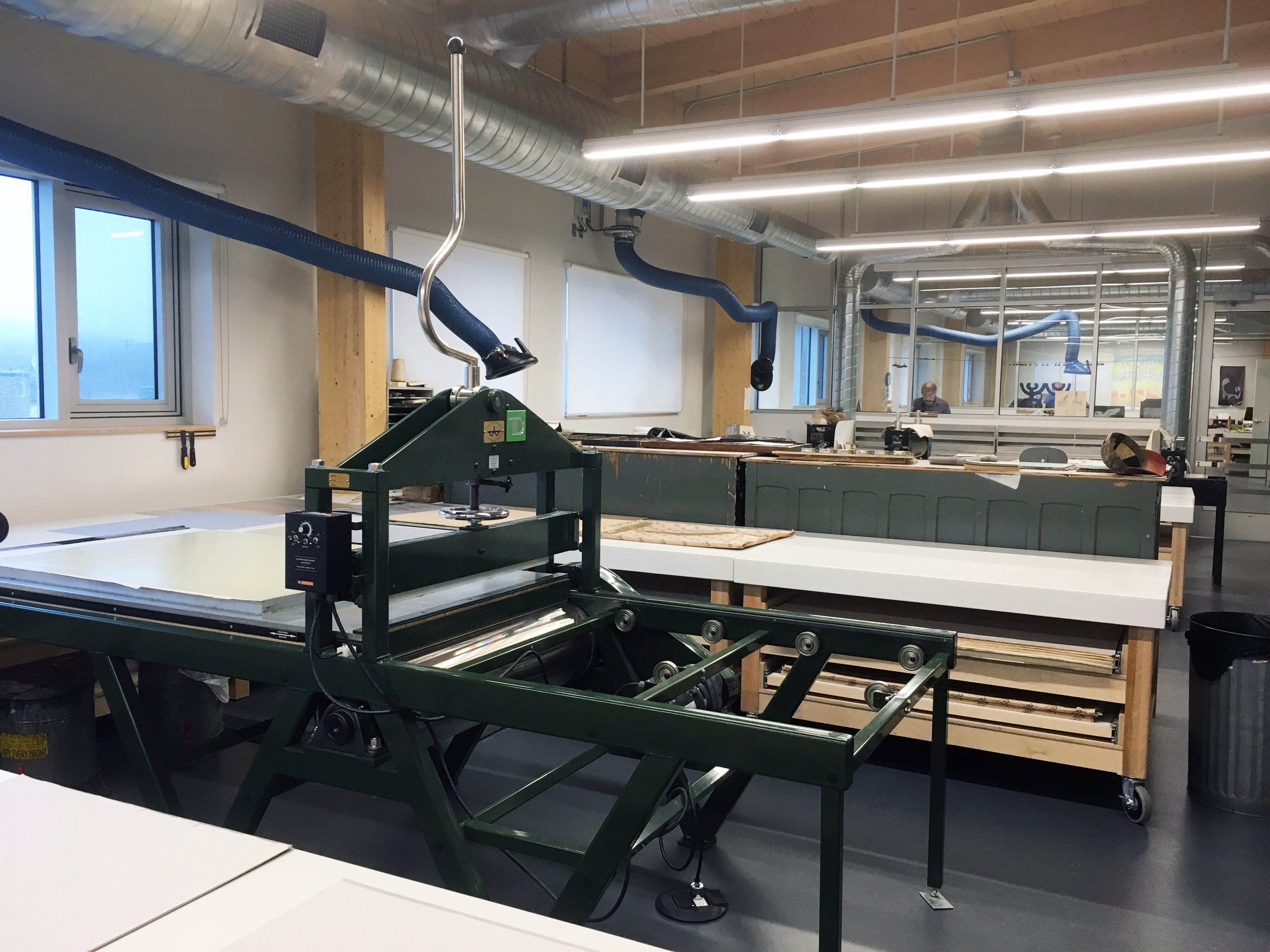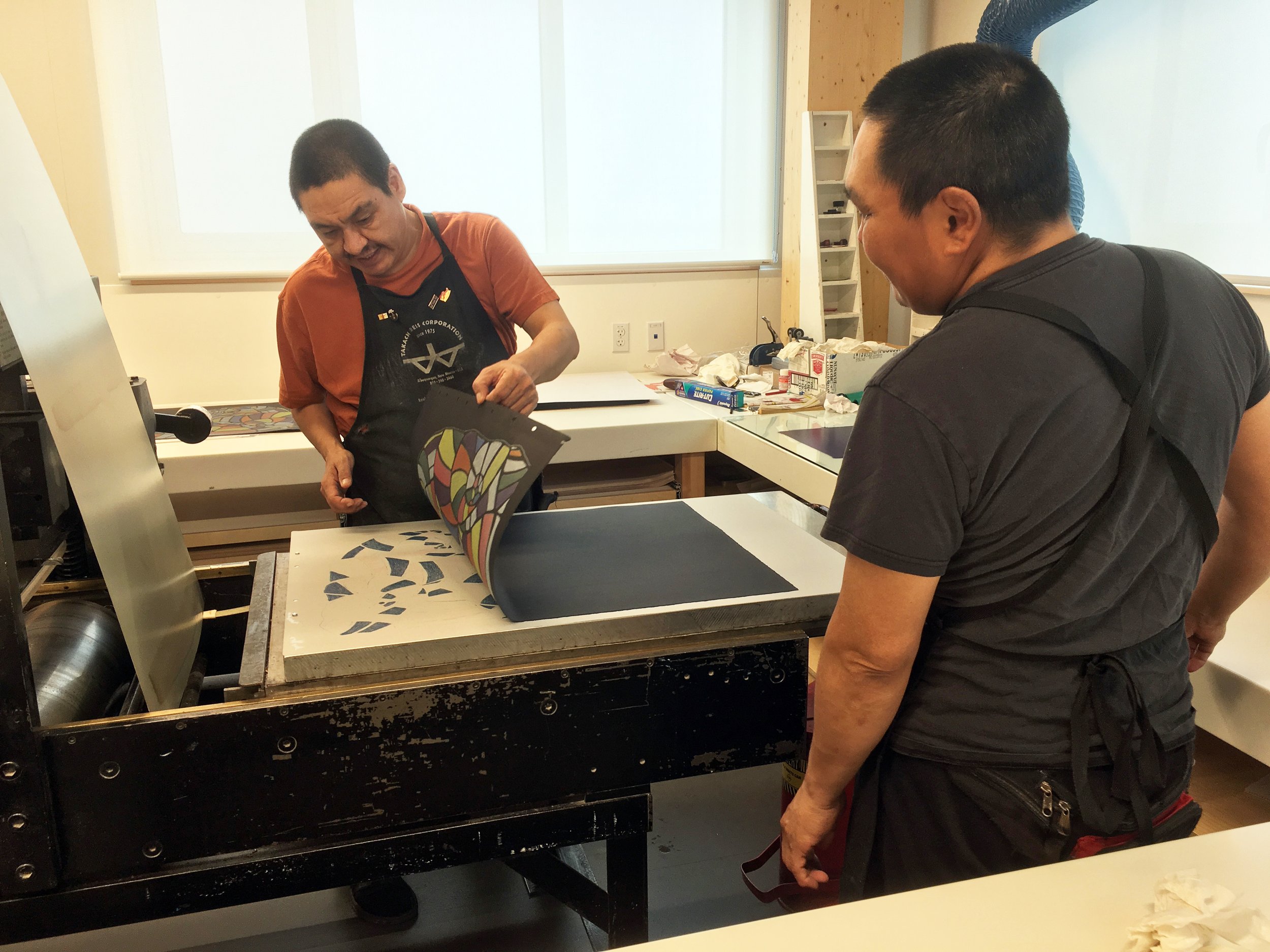Senator Patricia Bovey
Senator Patricia Bovey has made significant contributions to the Canadian cultural landscape as an advocate, museologist, gallery director and curator, professor and now as a member of the country’s highest legislative body. West Baffin Eskimo Cooperative caught up the Senator Bovey, to learn more about going from gallery work to the Senate and her long standing relationship to Inuit art.
So you represent the only Senator who brings a significant professional history of cultural advocacy, museum management and curatorial practice to the country's highest legislative body. Tell us a little bit about that remarkable journey.
I've been very fortunate over the years. I've had wonderful experiences, even as a child. I grew up in a family where the arts were really important. In fact, my mother was one of the founders of the Volunteer Committee at the Winnipeg Art Gallery and my father a historian, served for a time, as Director of what was then called the National Museum of Man (now the Canadian Museum of History). My own journey began as a student at the University of Toronto where, in addition to my studies, I had a number of summer jobs and winter part-time work at museums in Ottawa and Toronto. In May of 1970, I became a very young inexperienced curator at the Winnipeg Art Gallery, a position I had for a decade. It’s hard to believe that was 51 years ago. In 1980 I became Director of the Art Gallery of Greater Victoria for the next 19 years, before returning to Winnipeg as Director of the Winnipeg Art Gallery. After my tenure at the WAG, I founded the Buhler Gallery, a public gallery in Winnipeg’s St. Boniface Hospital. That was a particularly rewarding and terrific experience. Throughout all those adventures, I taught art history and Canadian cultural policy and participated on a number of governing boards in the arts and in post-secondary education. So, it's been a mesh of opportunities and experiences, but consistent through them all was navigating a balance between the creator and the community; supporting individual creators while engaging with the broader community groups I was serving. Those of us who’ve had the privilege of working in art galleries or museums, know our responsibility is as a meeting point between artists and audiences. That connector role taught me a great deal about building effective relationships. I will tell you a little story that will help to explain. I was two weeks into my current senate role, when a senator suggested perhaps I wasn’t qualified to be a senator because I don't have a political background. In that moment, I simply didn’t know how to respond, and believe me, I'm not often speechless. Two weeks later, on thinking about their comments I responded that throughout my fifty years of professional life, I have consistently given voice to multiple societal issues, from multiple perspectives, to multiple audiences, all the time, and worked with politicians of every political stripe at every level of government. That is exactly what we do in the Senate. So with that I realized perhaps I might be one of the most qualified people to be in the Senate. That key moment gave me my feet in the Senate as its first art historian and museologist.
In your role as an independent Senator, you have the opportunity to provoke important discussions, examining issues of national importance as they relate to the cultural sector. Can you give us an idea of those priorities that you've brought to the Senate?
My priorities haven't changed. My priorities are Canadians, artists and audiences, creators and communities. I firmly believe artists working in all disciplines, including dance, writing music, visual, art, and theatre, are the soul of a place, the soul of community, and ultimately the soul of humanity. Putting on my art historical hat, if you take a look back, you can see how artists have always given voice to societal issues by addressing life and societal crises in their work, long before society as a whole recognizes those issues. I brought all that thinking and those beliefs with me to the Senate. When I first took up this position and honour, I knew it was going to be complex and nuanced, and I’ve been consistent in my messages at the Senate level – the arts are vital! Of course there is wide support for museums, theatres and symphonies, but sometimes public discourse frames these institutions only as places of leisure or entertainment. I’m very public about my view that creative expression is absolutely core to every social issue from employment to education, health to the environment, tourism to crime prevention. I can go through a whole long list for as many people know, I've researched this over decades and I have the stats to back it up.
Can you give us a better understanding of the kind of work you do with Senate? Some of the projects or initiatives in which you’ve been involved?
What have I been working on in addition to all the review of legislation? The community aspect of what I do is particularly rewarding and enjoyable , and I feel we’re making headway with understanding the many diversities and concerns across Canada. First, I brought the need to do a study on Cultural Diplomacy to the Standing Committee on Foreign Affairs and International Trade. I'm very proud of the resulting report, and am truly grateful to my colleagues for taking it on. I think, in beginning, some wondered what it was all about and it took longer than was originally expected, given its depth and substance, but that report has made and continues to make a difference in many ways.
Also, along with my colleagues Senator Charlie Watt and Senator Dennis Patterson, I played a critical role in the creation of a Special Committee on the Arctic, of which I was Deputy Chair and I'm equally proud of that resulting report. Those who know me are amply aware of the interconnectedness that the Arctic holds for me. At the forefront, issues of the Arctic need to be seen as vital and integral to discussions about Canada as a whole. I'll go even further and say Inuit artists have over many decades portrayed that interconnectedness, whether the very early carvings people carried with them when they went on the hunt; or the shamanistic and spiritual aspects of Inuit life; or reflections on the environment; or depictions of landscape and lifestyles. The art of the North, Inuit art, is important - far more important than I think many realize. That Senate report by the Special Committee on the Arctic was the first time the Senate reproduced contemporary Canadian art in one of its reports and I'm very pleased that we paid artists reproduction fees! That’s been significant for me and the Senate, but there are many other irons in the fire too.
And one of those irons is the Advisory Working Group on Artwork and Heritage Assets. Can you tell me more about that initiative?
I actually chair that advisory group to the Senate’s powerful Standing Committee on Internal Economy, Budgets and Administration and have been a member since I've been in the Senate. We were charged with moving the Senate art collection from Parliament Hill’s Centre Block to the new Senate of Canada building located at 2 Rideau Street. That’s been done. We have since recommended a new policy for the restoration and preservation of Senate artwork and artifacts as part of a larger new Artwork and Heritage Policy.
We have also initiated four special projects. One is a display wall in the foyer of the Senate Chamber Honouring Canada’s Black Artists. The first installation was of the work of two artists from Western Canada, Yisa Akinbolaji and Chantal Gibson. These installations will rotate to showcase a range of work and regions. I understand that this is the first time Black Canadian artists have ever had their work exhibited in parliament. Naturally I’d like to see more spaces created for artists, underlining our role to ensure Canadian voices are heard in the Senate.
We have also commenced a program titled Cultivating Perspectives: A Virtual Art Exhibition by the Senate of Canada. Two cohorts of 13 curators each, representing each province and territory, are writing short essays about an artwork of their choice in the Senate collection. The first 13 are already line; the next group will be invited soon. This project gives various museological perspectives on artworks in the Senate, including several Inuit pieces. The third project is Museums in the Senate, an initiative for which one or two galleries or museums will have works from their collection installed in Senate committee rooms. The first, in the fall of 2021, will be Inuit art from the Nunavut and Winnipeg Art Gallery collections. Lastly, is the analysis of Indigenous art in the Senate which Greg Hill, the Audain Indigenous Curator at the National Gallery of Canada, did for us. He has made some excellent recommendations which we will be implementing. These four new initiatives are but some examples of major undertakings of the Advisory Working Group on Artwork and Heritage Assets.
Now, you touched on your Senate work with Arctic issues as they relate to Inuit artists. And I know you've had a long-time commitment to this. Can you elaborate on your connection to the North and your involvement with creator communities there?
My involvement with the North is a tapestry of events over a lifetime, even back to my childhood when the first Cape Dorset Annual Print Collection was released. As I mentioned earlier, my mother was a gallery volunteer and she and other gallery volunteers catalogued that collection in our living room. I was utterly fascinated by these amazing works. At that same time, my father was working on a book about the north for The Champlain Society. We also lived in England for a year when I was young and I was taken to France where I saw both historical and contemporary Inuit art. That too made an impact on me, all before I was 12 years old. George Swinton, so important in bringing awareness of Northern art to the South along with Jerry Twomey and James Houston, was a very close friend of my parents. I loved hearing George's stories of going up North and was thrilled when I went to their house as I got to see all their Inuit art. Those early subconscious and conscious experiences ingrained in me the importance of Northern creative expression.
When I got my first job as a student jointly at the Canadian Museums of Man and Nature, one of my roles was to provide tours of the museum’s Inuit galleries in French. And of course, later on, when I was a young curator at the Winnipeg Art Gallery we hired the first curator of Inuit art. It’s significant to know that under Director Ferdinand Eckhardt, the Winnipeg Art Gallery was the first Canadian art gallery to collect and present Inuit art as art, not as ethnographic objects. I started travelling to the North professionally in 1973. Later, when I was a Board Member with Canada Council for the Arts we developed special programs to encourage Indigenous artists to apply for funding, and again, when on the Board of Directors of the National Gallery of Canada, I was able to champion the work of Northern artists. So you see, the North, the Canadian Arctic and Inuit art, were intertwined with my personal and professional lives long before I was appointed to the Senate.
And now I have a final question. So basically what's next for you in the Senate? Of course, I'm particularly interested in a preview of work that you're doing that will impact Canadian artists in the North and South. I’d appreciate any insights on what we can expect moving forward.
There's lots to be done, and as I only have two more years left in the Senate I'm really trying to move a lot forward and the support from my colleagues in every group in the Senate is terrific. There's an energy, and an excitement and increasing awareness of the importance of the arts in society. I’m sponsor of the bill to create the first Parliamentary Visual Arts Laureate, a position for a visual artist to depict the work that's going on at Parliament Hill. Each appointment will be for two years, just like the existing Parliamentary Poet Laureate. Another project is my Declaration Respecting the Essential Role of Artists and Creative Expression in Canada, which I hope to put on the floor of the Senate in the fall. The national participation and input on this has been truly inspirational and I thank everybody, more than 600 artists, arts workers and supporters in every discipline, who participated in my consultations for this important initiative.
I continue to identify opportunities for further discussion about the international importance of Canadian arts and culture, particularly as it relates to Indigenous art. In fact, I recently attended a meeting of the Arctic Council’s Standing Committee of the Parliamentarians of the Arctic Region, and a meeting of the Canada-United Kingdom Inter-Parliamentary Association, where we talked about the Arctic and the importance of artforms being created there. You may also be aware that I’ve focussed on the copyright situation for Canada's indigenous artists too. I'm quite concerned about the international mass reproduction, appropriation and mass marketing of Indigenous cultural heritage. As a member of the Standing Committee on Social Affairs, Science and Technology I hope to move these and other issues forward. Likewise, on the Senate’s Standing Committee on Official Languages, I have been exploring the recognition of Indigenous languages as part of cultural expression. You’ll be hearing more about that in next few months.
There is lots to be done. So, stayed tuned, it’s going to be exciting!
I think we should recognize both the senate reports by title: Northern Lights: A Wake-Up Call for the Future of Canada, and Cultural Diplomacy at the Front Stage of Canada’s Foreign Policy – Both highlight Inuit art and the opportunities for Inuit Art. The former included the recommendation for the appointment of a Minister of Northern Affairs, and The Hon. Dan Vandal became the first minister of the new ministry as a result. The appointment of Her Excellency, Mary Simon as Governor General of Canada is likewise very important. An Inuit woman from Nunavut she becomes the first Indigenous Governor General in the history of Canada.
Looking forward, the Arctic Report’s recommendations regarding housing and internet infrastructure are critically essential for the Arctic and for Inuit artists. Having said that, it is the work of Inuit artists which have been the voice of Canada in many parts of the world for decades, and this should be acknowledged and applauded.
Also, since my 2019 visit to Cape Dorset, the Winnipeg Art Gallery has opened Qaumajuq, the Inuit Art Centre, the first feasibility studies for which were done during my time as Director of the Winnipeg Art Gallery. It is a stunning building which showcases Inuit art and the outreach the gallery is doing should increase the awareness and understanding of the work of Inuit artists.
As we deal with global issues of climate change and technological advances, the art of the Inuit and the works from Cape Dorset illuminate the lives, the lifestyles and the changing issues Inuit people face. The work which comes out of the Kenojuak Art Centre is to be celebrated. These studios are truly significant, and the centre is one of the most impressive printmaking studios I have seen anywhere with its light, space, equipment and accommodation of multiple modes of making prints.




















